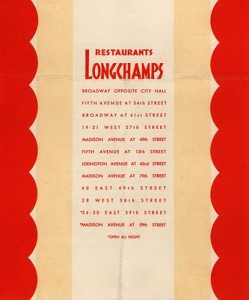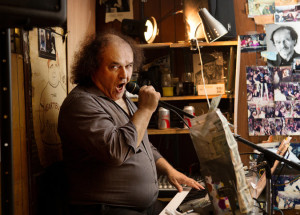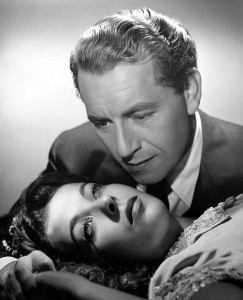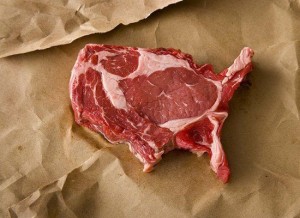During HG’s younger years in New York, there were many Hungarian (and Czech) restaurants on Lexington, Third and Second Avenues in the East 80’s and 90’s. The Czech restaurants specialized in tasty duck dishes. HG characterized the Hungarian eateries as “goulash by candlelight joints.” One of their common features was violin music provided by a “Gypsy” musician. The “Gypsy” would swoop down on individual tables and with many swooping gestures and soulful glances provide the diner with renditions of schmaltzy middle European cafe favorites. The object was to enhance the romantic mood of the diners. Somehow it worked (or maybe it was the copious amount of Egri Bikaver “Bull’s Blood” Hungarian red wine HG consumed). The “Gypsy” would continue to saw away until he was tipped. HG far preferred the “oompah, oompah” music provided by the band at Luchow’s, the glorious German restaurant on 14th Street. There were few jollier places in New York than Luchow’s during Christmas season when the venerable walls were adorned with holly and sparkling lights and the band focused on happy carols. Another pleasant winter music dining venue was the Edwardian Room of the Plaza Hotel. A cocktail pianist tinkled away in the background as diners ate in the handsome room gazing out at snow falling on Central Park. HG recalls a little steak house (name, alas, forgotten) where the owner, accompanied by a portable keyboard, sang show tunes to individual tables. His whiskey roughened voice was perfect for “Fugue for Tinhorns” from “Guys and Dolls.” And, then there’s Sammy’s Romanian on the Lower East Side. For many decades Sammy’s has featured music from singers, violinists and pianists singing old Yiddish music hall chestnuts and some popular melodies interspersed with low end, politically incorrect humor. The latest incarnation is Dani Luv, an Israeli born pianist with a killer Louis Armstrong impression. His audience, liberally stoked with vodka, garlic and chicken fat, is raucously appreciative.
Music For Dining
July 15th, 2015 § 2 comments § permalink
Christmas Restaurant Nostalgia Part One: Luchow’s
December 11th, 2013 § 0 comments § permalink
The very best restaurant in the world during the Christmas holiday season was the long gone (opened in 1882 and closed in 1986) temple of German gastronomy, Luchow’s on New York’s East 14th Street. An interior of dark oak, smoked glass and crystal. Every inch was festooned with colorful decorations and pine wreaths. Noisy and jolly. A German oompah band playing the songs of the season. HG/BSK’s kids loved it and, restraining intense excitement, displayed excellent restaurant manners. The food? Ah, the food. For the kids there were grilled bratwurst with home fried potatoes. BSK usually had a starter of smoked salmon and a main of crisp skinned roast duck with red cabbage and a buttery potato puree. For HG there was a triple header: Rollmops (pickled herring rolled around dill pickle); pfefferlinge (ragout of wild mushrooms in a peppery sour cream sauce); schlemmerschnitte (steak tartare topped with abundant beluga caviar). For dessert: Baked Alaska flamed in brandy. (Once a waiter set his apron on fire while setting the desert alight and the tension before the flames were put out only added to the exhilaration of the dinner). The kids drank Shirley Temples. BSK had appropriate white and red wine. HG had (much, much) robust dark beer. Joy was unrestrained.
Teutonic Memories
December 9th, 2013 § 0 comments § permalink
Pleasant dinner last night. Divided the cooking duties. HG fried potatoes and cooked bratwurst (simmered in beer for 15 minutes and then grilled to a brown crisp). BSK made sublime sauerkraut. Drained Bubbie’s kraut and cooked it with onions, apples, olive oil and a bit of chicken stock. Subtle, non-acidic flavors. So. Kraut and spuds were first rate. Brats were okay. Just okay. Plenty of pungent Polish mustard and Bubbie’s Bread and Butter pickles plus Shiner Bock Beer (“The Pride of Shiner, Texas”) helped the cause, but just barely. It made HG muse: “Where are the brats of yesteryear?” For years one could get inexpensive, succulent platters of brats-kraut-home fries in scores of German restaurants throughout the five boroughs of New York City. Luchow’s, Blue Ribbon, The Heidelberg and Volk’s were the leaders of the pack and HG quaffed much beer at these Teutonic shrines of hearty eating. Other than The Heidelberg (opened in 1936) they are all gone, alas. Of course New York, being New York, still offers authentic German Food — and the great Yorkville butcher Schaller & Weber sells some of the finest brats around — but the golden age of cheap and delicious NY German restaurants is over.
No to Nostalgia
July 12th, 2013 § 2 comments § permalink
HG/BSK watched a World War Two propaganda movie (set in an improbable Poland) with perky Ida Lupino and stiff Paul Henreid. Excruciating. Terrible acting. Moronic plot. Next night watched Detective Story, the film adaptation of Sidney Kingsley’s Broadway hit play of the same name. When it was released the film was lauded for its realism. Hmmm…Kirk Douglas and Eleanor Parker are the stars and the deliver stagey, scenery-chewing performances. William Bendix, in a supporting role, is the only actor in the film who seems to have a grasp on naturalist performing. HG/BSK agreed: Today’s movie actors are infinitely better than yesterday’s. Yes, there were interesting personalities in the past (Cagney, Bogart, Gable, etc.) but few actors with the abilities of today’s stars. No one with the range of Meryl Streep, Philip Seymour Hoffman and many others. Now, how does this relate to HG’s main focus, food? Well, HG may get nostalgic, and rightfully so, about long closed classic New York restaurants like Gage & Tollner, Luchow’s and Christ Cella; also, HG may get a bit wistful recalling the hearty blue collar eats of a New York that simply does not exist anymore. But, the reality is that today’s restaurant cooking is much better than that of the past. There is more emphasis on fresh, local ingredients and less use of butter, cream and heavy sauces. Greater use of a wide range of international ingredients. HG/BSK thought about this while enjoying imaginative dishes at 3 Petit Bouchons, a charming Montreal bistro. Grilled octopus with grilled potatoes. Cod with fiddlehead ferns and asparagus. Duck confit on Waldorf salad. Unusual sauces. A light touch. Dishes that would never have appeared on a menu 40 years ago. Also, because of changes in immigration patterns and disruptions in Asia and the Middle East, today’s restaurant diner (especially in New York) can taste extraordinary (and often very inexpensive) dishes from many parts of China as well as Thailand, Burma, Malaysia, India, etc. And, excellent Syrian, Lebanese, Turkish food abounds. The exposure to these diverse cuisines and the availability of the ingredients to prepare them has been one of the great boons to our restaurant culture — expanding palates and influencing chefs in the most positive way. To give you an idea of how insular cuisine was (even in New York) the big town in the 1950’s had only one Mexican restaurant — Xochitl. And, that was quite ordinary and Americanized.
HG: Steak Patriot
April 29th, 2012 § 0 comments § permalink
HG rarely waves the flag, believing, to paraphrase Dr. Johnson, that patriotism is the last refuge of fools and knaves. However, when it comes to steak, HG is a red-blooded, Yankee Doodle boy. Nothing compares to American steak (prime,of course). HG never had a good steak in Paris. Much lauded steak frites in a Paris bistro would get thumbs down from discerning New Yorkers (men and women who learned to eat steak on Steak Row and at Peter Luger’s). Alec Lobrano, the most informed and fair minded of Paris food writers, likes the steak at Le Severo in that city. HG and BSK sampled the steak there and found it only passable. However, steak tartare at Severo and at Le Stella and many other Paris eateries is exemplary. German restaurants in New York prepared great steak tartare in years gone by (Luchow’s covered its steak tartare with a generous layer of black beluga caviar). The great raw beef dish disappeared along with New York’s most fabled German restaurants.
If you rent an apartment in Paris, visit the Hugo Desnoyer butcher shop in the 14th and buy a rump steak (Lobrano’s suggestion) and grill it at home. And, if you’re renting a New York apartment, pick up a New York strip at Lobel’s on Madison Avenue. One pound strip: $47.98. (Hey, you only live once).
Longchamps: Affordable Dining Magic
March 14th, 2011 § 5 comments § permalink
While watching “Boardwalk Empire“, the HBO series about Atlantic City’s prohibition days, HG’s thoughts turned to Longchamps, that long gone, magical chain of New York restaurants.
Where’s the connection ? Well. One of the principal bad guys in “Boardwalk Empire” is New York crime kingpin (and World Series Fixer!) Arnold Rothstein. A.R. had a brother-in-law named Henry Lustig who was in the food business. A.R. owned an attractive piece of real estate at 78th and Madison. A.R. put up the money and real estate and a restaurant chain, Longchamps, was born. Longchamps was, of course, named after the Paris race track. The name was apt: A.R. and Lustig were gamblers (A.R. was shot and killed while playing cards). Both men loved horses and they wanted the restaurant chain to evoke a Parisian flair (though the cuisine was American and international). Eventually there were 12 Longchamps restaurants in New York. They were pure theater. The colors were red, gold, yellow and black. The interior design was by the German art deco expert Winold Reiss (with an assist from New York architect Ely Jacques Kahn). Multi level, beautifully lit, Longchamps had suave service and excellent wine lists. In the beginning, it copied the European custom of forbidding tipping by simply adding a 10% charge to the bill. The food was marvelous. And, the price was right. Not cheap. Not super expensive. Just in the middle. Everything went well until 1946 when the IRS slapped Lustig with a $10 million tax bill and a fraud indictment (he spent four years in prison). Longchamps was soon in disarray and losing money. Jan Mitchell, the remarkable restaurateur who had revived Lüchow’s, the great German restaurant on 14th Street, bought Longchamps in 1959 and quickly restored it to glory. From 1959 to 1967 (when Mitchell sold out and the chain disappeared), HG was a frequent customer. Pot a Feu (better than Paris); lush spaghetti with chicken livers; creamy chicken curry; lamb chops; eggs benedict and the ultimate roast beef hash. Breakfast. Lunch. Dinner. Longchamps always hit the spot. Following their wedding in judge’s chambers on Foley Square, HG, BSK and the wedding party celebrated with eggs benedict and champagne at the Longchamps opposite City Hall. In memory, every meal at Longchamps was a celebration.




